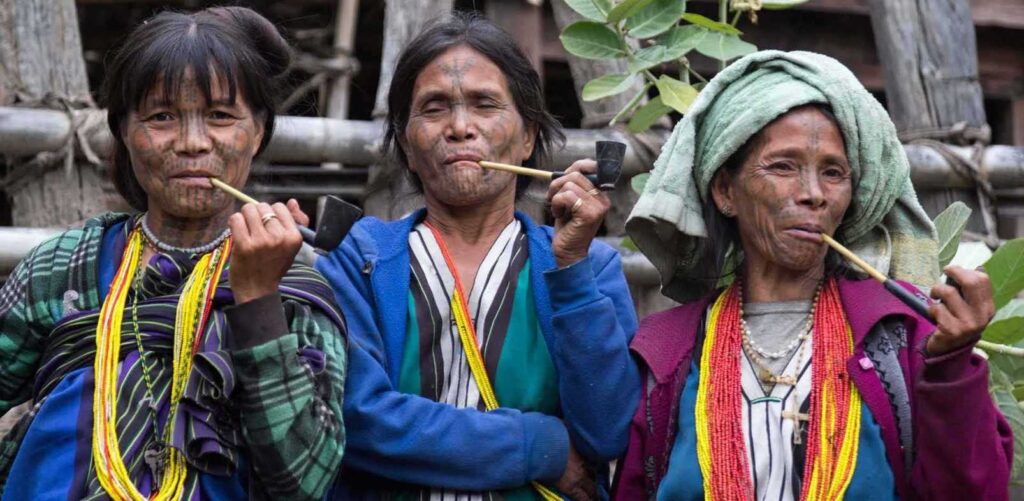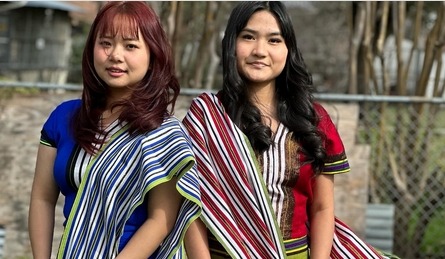
Chin State: People, Culture, History, and Traditions of Myanmar’s Mountain Region
Chin State, located in the mountainous northwestern region of Myanmar, is one of the country’s most culturally diverse and geographically stunning states. Known for its dramatic landscapes, ancient tribal traditions, and proud ethnic identity, Chin State remains a place where heritage and nature coexist in a remarkable way. The region borders India’s Mizoram and Manipur states to the west, giving it strong cultural connections with neighboring communities. With more than 50 tribes and sub-tribes, each with distinct languages, customs, and traditions, Chin State stands as one of Myanmar’s most ethnically rich regions.
Geographical Landscape
Chin State is primarily mountainous, with steep hills, deep valleys, and winding roads. The Chin Hills are part of the larger Arakan Mountain range, creating a rugged terrain that historically shielded the Chin people from foreign influence and preserved their ancient customs.
Key geographical characteristics include:
Mount Victoria (Nat Ma Taung) – The highest peak in Chin State at 3,053 meters, located inside Nat Ma Taung National Park.
Cool climate – Temperatures drop significantly during winter, especially in high-altitude towns like Kanpetlet and Mindat.
Lush forests – Home to rare bird species, orchids, oaks, and pine forests.
Fast-flowing rivers – Such as the Manipur, Boinu, and Laymyo rivers.
Because of its elevations, Chin State has one of the coolest climates in Myanmar, attracting nature lovers and travelers seeking scenic mountain experiences.
The Chin People: Diversity Across Tribes
Chin State is home to numerous tribes, each with its own language, identity, and cultural heritage. Major Chin tribes include:
Lai (Hakha & Thantlang tribes)
Mizo-related tribes
Mara
Zomi
Munnel
Cho
Yindu
Ashó Chin (mostly in Sagaing/Yangon regions)
Khumi
Daai Chin
Ngawn
Linguistically, the Chin belong to the Tibeto-Burman language family. Many Chin languages are mutually unintelligible, even between neighboring tribes, contributing to a rich and complex cultural mosaic.
Despite this diversity, the Chin share common cultural traits: respect for elders, strong community ties, craftsmanship, and deep spirituality.
Historical Background
The Chin people are believed to have migrated from the Tibetan plateau thousands of years ago. Over centuries, they settled in the Chin Hills, where they formed village-based societies governed by chiefs.
Pre-colonial era
Chin communities traditionally lived in fortified hilltop villages. Life centered around agriculture, hunting, weaving, and community rituals. Each village functioned independently, with its own leadership and ancestral practices.
Colonial period
The British annexed Chin Hills in the late 19th century, introducing Christianity through American and British missionaries. This drastically transformed Chin society, particularly in northern Chin State, where Christianity remains dominant today.
Post-independence
After Myanmar gained independence in 1948, Chin State became one of the country’s recognized ethnic states. Despite modernization, the Chin people continue to maintain their rich cultural heritage.
Tattooed Chin Women: A Unique Cultural Legacy
One of Chin State’s most iconic traditions is the face-tattooing custom among Chin women. Although now largely discontinued, this practice is deeply rooted in Chin history.
Meaning of Face Tattoos
Different Chin tribes had different tattoo designs:
Spider-web patterns (in Mindat and southern regions)
Dotted designs (in Hakha and northern regions)
Thick lines across the cheeks and forehead (in certain tribes)
The tattoos symbolized beauty, tribal identity, bravery, and cultural pride. Some legends say tattoos protected Chin women from being taken by ancient invaders; others say they marked adulthood and tribal belonging.
Cultural Significance
Tattooed Chin grandmothers remain living symbols of traditional Chin culture. They are often photographed and interviewed by visitors, helping preserve their stories for the world.
Religion and Spiritual Life
Religion in Chin State is diverse, shaped by ancient beliefs and later missionary influence.
Christianity
Today, over 85% of Chin people are Christians, especially Baptists and Catholics. Churches play a central role in community life, hosting:
weddings
harvest festivals
Sunday worship
youth programs
choir and hymn traditions
Chin Christians are known for their strong choral singing and musical talent.
Animism and Nat Worship
Before Christianity, Chin communities practiced animism:
honoring ancestors
sacrificing animals during important ceremonies
believing in spirits (nats) inhabiting mountains, forests, and rivers
These traditions still survive in remote villages and coexist with modern beliefs.
Traditional Culture and Customs
Chin culture is rich, colorful, and deeply rooted in tribal identity.
1. Traditional Clothing
Chin clothing varies by tribe.
Women typically wear:
handwoven longyis with bold patterns
shawls or blankets with red, black, and white stripes
beaded necklaces
Men often wear:
red-striped shawls
woven jackets
traditional headscarves
Chin weaving is famous throughout Myanmar, with intricate designs that reflect tribal stories and ancestral symbols.
2. Music and Dance
Chin people love singing, dancing, and playing traditional instruments.
Common instruments include:
Khuang (traditional drum)
Flutes and bamboo pipes
Guitars (introduced by missionaries)
Gongs
Dances depict courtship, hunting scenes, festivals, and community celebrations.

3. Festivals
Chin State is home to unique festivals:
Chin National Day
Celebrated on February 20, marking the abolition of the feudal system. Includes:
parades
wrestling competitions
traditional dancing
cultural exhibitions
Harvest Festival (Kut)
Celebrates abundance and gratitude after the farming season.
Thanksgiving Festival (Christian celebration)
Church communities gather to offer thanks, food, and donations.
4. Handicrafts
Chin embroidery and weaving are world-renowned. Their textiles are used for longyis, bags, shawls, and blankets. Bamboo and wood crafts are also common.
Cuisine of Chin State
Chin food is simple, hearty, and deeply tied to the mountainous environment.
Popular dishes include:
1. Sabuti (Chin noodles)
A traditional noodle dish made with rice flour, vegetables, and meat broth.
2. Bamboo shoot dishes
Bamboo shoots are used in soups, curries, and salads.
3. Smoked meats
Chin households often smoke pork or beef over the fireplace, storing it for months.
4. Chin-style vegetable soup
A mild yet flavorful soup commonly eaten with rice.
5. Spices and herbs
Chin cuisine relies on fresh herbs, chili, garlic, and ginger.
Because of the colder climate, Chin dishes are warm, smoky, and comforting.
Tourism and Landmarks
Chin State is gradually becoming a popular destination for nature and culture enthusiasts.
1. Nat Ma Taung (Mount Victoria)
A major attraction located in Nat Ma Taung National Park, known for:
breathtaking mountain views
rare birds and flora
scenic trekking routes
butterfly species unique to the region
2. Mindat
Famous for tattooed Chin women, mountain trekking, and indigenous culture.
3. Kanpetlet
A peaceful hill town used as a base for climbing Mt. Victoria.
4. Falam and Hakha
Chin State’s major towns, offering local markets, churches, and scenic viewpoints.
5. Rih Lake
A heart-shaped lake in Chin State near the India border. Believed in Chin folklore to be a spiritual gateway, it attracts both Burmese and Indian travelers.
6. Traditional Villages
Remote villages showcase:
ancestral ceremonies
weaving traditions
stone memorials
ancient tribal customs
These villages offer authentic cultural experiences.
Economy and Livelihood
The Chin economy is primarily based on:
1. Agriculture
Chin people grow:
corn
rice
millet
potatoes
tea
coffee
oranges
vegetables
Chin coffee, especially from Chin Hills, is gaining international attention for its quality.
2. Handwoven textiles
Chin fabrics are popular across Myanmar and abroad.
3. Forestry and livestock
Goat and cattle farming are common.
4. Tourism
Hiking, cultural tours, and eco-tourism continue to grow.
Despite challenges posed by geography and infrastructure, Chin State remains resilient and resourceful.
Conclusion
Chin State is a region of extraordinary cultural richness, natural beauty, and historical depth. Its people, spread across dozens of tribes and communities, preserve unique traditions—from facial tattoos and weaving to festivals and mountain lifestyles. Surrounded by rugged hills and blessed with cool weather, Chin State offers a blend of heritage, spirituality, and scenic wonder.
For those seeking authentic culture and breathtaking landscapes, Chin State stands as one of Myanmar’s most remarkable destinations, where ancient customs and modern life come together with pride and resilience.
Related posts:
No related posts.
